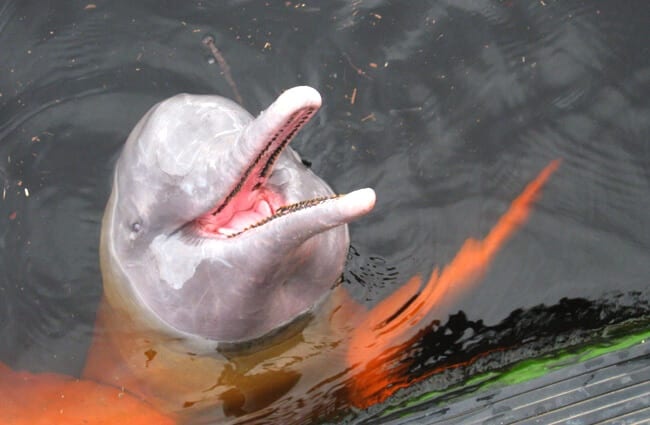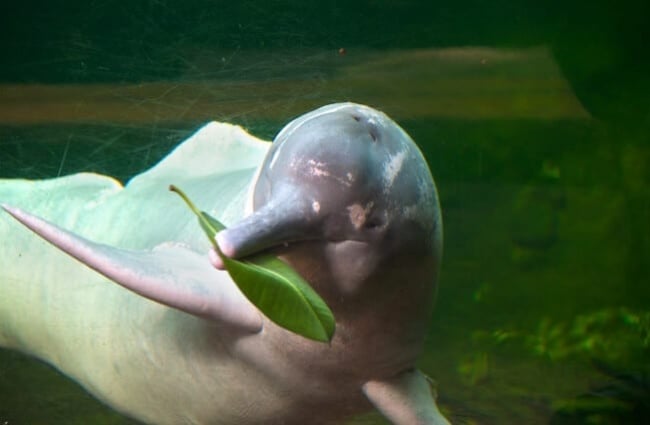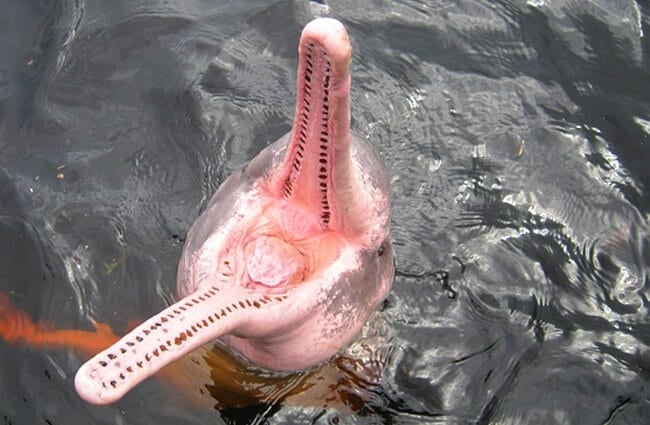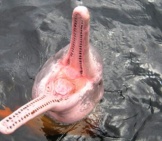The local people know Amazon dolphins by many names, including Amazon river dolphin, pink river dolphin, boto, and bufeo, to name a few. These marine mammals get their name from their unique pinkish color, which is more prominent in males.
As river dolphins, they live only in fresh water bodies, particularly rivers and tributaries. They are the largest river dolphin species in the world. Read on to learn about the Amazon dolphin.
Description of the Amazon Dolphin
This species weighs up to 408 lbs. and grows up to 8.4 ft. long, with males longer and heavier than females. These large marine mammals are light pink in color, and some individuals have gray mottling. Male Amazon dolphins have a more distinct pink color than females. They also have a somewhat reduced dorsal fin, which is short and extremely wide, giving it an appearance similar to a boat keel.
Interesting Facts About the Amazon Dolphin
These dolphins are unbelievably unique, both in shape and behavior. They are odd looking creatures, with a number of unique adaptations that make them different from many other dolphin species.
- Sexual Dimorphism – Like many other animal species, Amazon dolphins have some level of sexual dimorphism, which means you can tell the difference between males and females by appearance. Males are larger and heavier than females, and a brighter pink color.
- Large Lads – These dolphins are unique among cetaceans (whales and dolphins) because the males are usually larger than the females. In other dolphins, the females tend to be larger than the males!
- Nodding Along – Unlike their ocean-swimming counterparts, these dolphins do not have fused cervical vertebrae. To put it simply, the bones in their necks are flexible and can move freely. This allows them to turn their heads side to side. Beluga whales also share this unique trait.
- Shallow Swimmers – Along with flexible necks, these dolphins also have very large pectoral fins. Both of these traits give them the ability to make tight turns and maneuver more easily. This is extremely useful when moving through flooded forests and other areas of dense vegetation.
Habitat of the Amazon Dolphin
Amazon river dolphins live in a number of freshwater habitats across the Amazon River Basin. They can be found in rivers (of course), but also river basins, canals, lakes, tributaries, and the ends of rapids and waterfalls.
When the rainy season arrives, they will also swim in smaller creeks, floodplains, and even into flooded forests. The females remain in these flooded areas with their babies for longer than males, because they are more protected from predators in these areas.
Distribution of the Amazon Dolphin
These dolphins can be found throughout the vast majority of the Amazon River Basin. Some countries that they inhabit include Venezuela, Bolivia, Peru, Brazil, Ecuador, and Columbia.
They will travel anywhere the water can take them, including into flooded forests and areas usually high and dry. They migrate between deeper rivers in the dry season, and shallower waters in the wet season. On average, they travel nine miles per day, but this differs based upon the season.
Diet of the Amazon Dolphin
Of all dolphin species, Amazon dolphins have some of the most diverse diets. Probably because they feed in areas most whales and dolphins never have access to. They feed on at least 53 different species of fish, including croakers, piranhas, tetras, eels, and more.
Some of their teeth are uniquely shaped for crushing, which allows them to feed on crabs and other crustaceans, as well as turtles. They have also been known to hunt in cooperation with giant otters and tucuxi dolphins.
Amazon Dolphin and Human Interaction
As is the case with many inhabitants of the rainforest, these dolphins conflict with humans relatively frequently. Fishermen will overfish the species available in the rivers, and see the dolphins as competitors for their livelihood.
Dolphins are also accidentally (and purposefully, for the aforementioned reason) captured in fishermen’s nets. Degradation of rainforest habitat, and pollution of waterways, also adversely impacts these dolphins. Because of all these threats, the IUCN lists this species as Endangered.
Domestication
Humans have not domesticated these dolphins in any way.
Does the Amazon Dolphin Make a Good Pet
No, Amazon dolphins do not make good pets. Like all marine mammals, the Marine Mammal Protection Act makes harming, killing, owning, or otherwise molesting these animals illegal.
Amazon Dolphin Care
These dolphins are difficult to keep in a zoological or aquarium setting. Only three Amazon dolphins reside in aquariums today. They live at the Acuario de Valencia in Venezuela, the Duisburg Zoo in Germany, and the Zoologico de Guistochoca in Peru. Because there are so few in a zoological setting, it is difficult to conduct research and perfect their care.
Behavior of the Amazon Dolphin
For the most part, these dolphins are active both day and night, sleeping in short stints. However, most of their activity and hunting occurs at daybreak and sunset, making them primarily crepuscular. Unlike many other species of cetaceans, it is not uncommon to see solitary dolphins or pairs. Though some researchers have spotted them in larger pods, this is unusual.
Reproduction of the Amazon Dolphin
Amazon dolphins reproduce during their breeding season in May and June. They reproduce at this time to ensure the young dolphins, called “calves,” are born during flood season. Males reportedly carry objects around during the breeding season, but it is unknown what purpose this has in breeding.
After mating, females have a gestation period of approximately 11 months. They give birth to a single calf, and nurse it for a year before weaning it off mother’s milk. The calf remains with its mother until it is 2 or 3 years old.
Beliefs, Superstitions, and Phobias About the Amazon Dolphin
Amazon River mythology tells of Amazon dolphins becoming shapeshifters, and emerging from the water disguised as beautiful men or women. Male dolphins posing as men then attempt to woo female humans, and female dolphins posing as women attempt to woo men. The results of these interactions usually end with the wife giving birth to a baby.
Researchers believe these tales might have arisen as an explanation for inbreeding or babies conceived out of marriage in the small villages by the river. This should go without saying, but Amazon dolphins are not shapeshifters!











![Red Angus Closeup of a beautiful Red Angus cowPhoto by: U.S. Department of Agriculture [pubic domain]https://creativecommons.org/licenses/by/2.0/](https://animals.net/wp-content/uploads/2020/03/Red-Angus-4-238x178.jpg)












![Red Angus Closeup of a beautiful Red Angus cowPhoto by: U.S. Department of Agriculture [pubic domain]https://creativecommons.org/licenses/by/2.0/](https://animals.net/wp-content/uploads/2020/03/Red-Angus-4-100x75.jpg)

